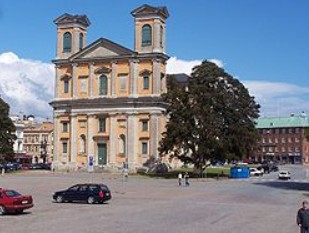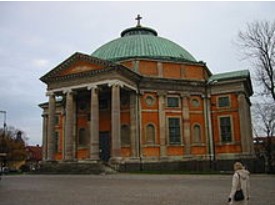


Karlskrona is a locality and the seat of Karlskrona Municipality, Blekinge County, Sweden with 35,212 inhabitants in 2010, It is also the capital of Blekinge County. Karlskrona is known as Sweden’s only baroque city and is host to Sweden’s only remaining naval base and the headquarters of the Swedish Coast Guard.

Geography
The city centre is located on the island of Trossö. The islet of Stumholmen was formerly property of the Navy and today it houses the National Naval Museum (Marinmuseum).
Heliga Trefaldighetskyrkan (Church of Holy Trinity)
History
The city was founded in 1680 when the Royal Swedish Navy was relocated from the Stockholm area to the Trossö island which had up until then been used chiefly for farming and grazing. At the time Sweden was the dominant military power in the Baltic sea region, but needed a better strategic location against Denmark, since southern parts of Sweden had been conquered only a few decades ago (see the Torstenson War). The Swedish fleet tended to get stuck in the ice during winter while located to Stockholm and was therefore moved south. The island had a very strategic position with short sailing distances to the German and Baltic provinces. The city name means Karl’s Crown in honour of King Karl XI of Sweden, the name being inspired by the name of the city Landskrona.
The city grew quickly and by 1750 Karlskrona had about 10,000 inhabitants. It was then one of the biggest cities in the country. Most of the baroque buildings from this era are still standing, which is why the city centre is architecturally uniform. There are three important churches in Karlskrona, the first being Fredrikskyrkan (The Frederick church). It was designed by Nicodemus Tessin the Younger, who was influenced by European architecture. The foundation of that church were laid in 1720, and it was inaugurated in 1744. It differs from usual Swedish churches in its yellow color and its adornment.
The church Heliga Trefaldighetskyrkan (Church of Holy Trinity), also called The German Church, was built between 1697–1709, following Tessin’s drawings. It is likewise located at the market square in the centre core. The dome-shaped roof takes its influence from Italian architecture and is rarely seen on Swedish churches.
The third city church is the Karlskrona Admiralty Church (Amiralitetskyrkan). The church was built in 1685 in red-painted wood. Outside the church there is a well-known statue called Rosenbom.
The shipyard in Karlskrona was established almost at the same time as the city. It was a necessity because of the heavy losses the Swedish navy had suffered in 1689. In 1711, the shipyard was Sweden’s largest industrial employer with 1,100 workers. The oldest dock, the Polhem dock, is cut in the cliff itself and is still in use. It got its name from Christopher Polhem ("The Swedish DaVinci", a famous scientist with several inventions still in use).
The city has kept its street structure since its foundation. Since the streets all follow a grid pattern the winds can blow freely from the ocean right into the heart of the city.
The naval installations there has been declared a UNESCO World Heritage Site.
In October 1981 the Whiskey-class Soviet submarine S-363 (called "U137" by the Swedes) ran aground in the archipelago just outside Karlskrona. The media characterized it as the "Whiskey on the Rocks" affair. The incident caused a temporary rise in tensions between Sweden and the Soviet Union. While the submarine’s grounding was inadvertent, and likely the result of inebriation among the crew, the submarine almost certainly was engaged in an unspecified covert mission at the time.
Today

The most important day in Karlskrona is the day before midsummer’s eve. On that day a big fair takes place and attracts tens of thousands to visit Karlskrona. The fair is called Lövmarknaden (The Leaf Fair) and is very popular among the locals.
The main square of Karlskrona is the biggest in Scandinavia, and actually the second biggest in Europe, after the Red Square of Moscow.
Every year in late July/early August a popular festival called The Sail takes place in the harbor of Karlskrona. Usually it is a place where families go to have something to eat and drink, and perhaps watch the sailing boats lined up at the pier. During the sail, the seascouts of Karlskrona will row a boat carrying torches along the docks while playing the national anthems for the visiting ships.
The old architecture together with the naval installations comprise the major tourist attractions of Karlskrona. The city has a pleasant atmosphere and is one of the highlights of south-east Sweden. Outside the city lies the archipelago of Karlskrona, the most southern of the Swedish archipelagos. Several islands are connected to the city by ferries.